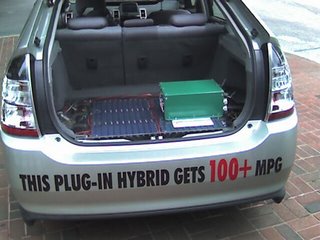Plug-In Hybrids Are On The Way
Plug-In Hybrids Are on the Way
Last week in Washington, DC -- even as top executives from Ford, Chrysler, and GM asked lawmakers to subsidize the installation of more ethanol pumps at filling stations -- makers of new battery systems were letting U.S. senators test-drive prototype cars that get over 100 miles per gallon, but don't require any new infrastructure.
The vehicles in this road show, which are called plug-in hybrids, were Toyota Priuses retrofitted with large advanced battery packs that can be charged overnight and used to power the cars electrically for short trips. "If you look at how people typically drive cars, about half of the driving that you use gasoline for you could be using the electricity that comes out of your wall," says Martin Klein, CEO of Electro Energy of Danbury, CT, which developed the battery pack and control system for one of the cars on display in Washington. What's more, he says, the existing power grid means that "the infrastructure is all in place."
...
Ordinary hybrids get all their energy from gasoline, but they are much more efficient than conventional cars because extra energy from the engine and braking is stored in a battery pack, which powers an electric motor to boost acceleration and even fuel the car completely for short distances at low speeds. The boost allows hybrid automakers to use a smaller, more efficient internal-combustion engine without sacrificing performance. And hybrids also save gas by turning off their engines when stopped in traffic or at a stoplight. Overall, the fuel economy of a conventional Prius is around 50 miles per gallon.
Plug-in hybrids have a larger battery pack, which allows them to run on the electric motor much longer -- for 20-25 miles in the case of the Electro Energy car. The battery is charged from an ordinary electrical outlet. Thus, a commuter who drives 10 or 15 miles to work on city streets could recharge the battery at night and make the commute entirely on electricity. Others would need the gasoline engine at highway speeds, but could rely on the battery while driving in the city. When the energy stored up overnight runs out, the car slips into conventional hybrid mode until the next charge. This gives the vehicle an advantage over all-electric vehicles, which have been hampered by limited range due to limited battery storage capacity.

Let's calculate this back to liters and kilometers so I can get an idea about the mileage.
One US gallon is about 3.8 liters. One US mile is about 1.6 kilometers.
This car uses 3.8 liters to travel 160 kilometers. Then the mileage is 1 in (160 / 3.8) = 42.1.
Not too shabby. Cars that I know of get 1 in 18 at best.










No comments:
Post a Comment